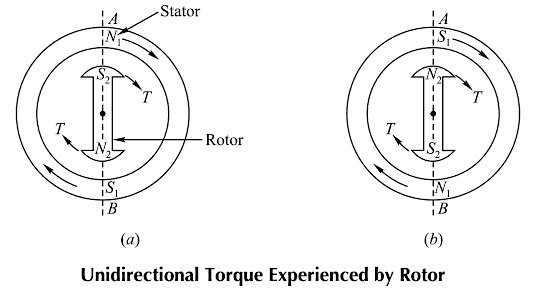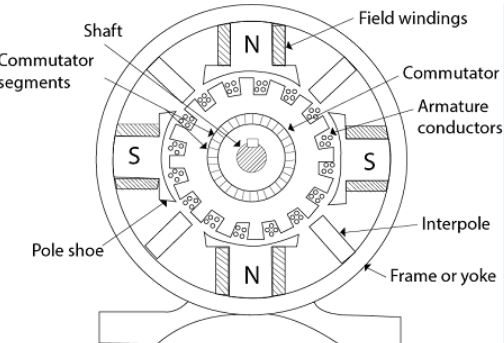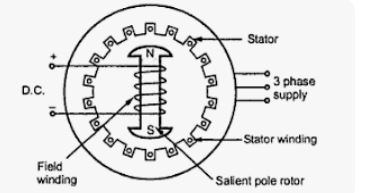Why Synchronous Motor not Self Starting
When a three-phase supply is given to the stator of a three-phase wound synchronous motor, a rotating field is set up in the air gap which rotates at synchronous speed (Ns = 120f/p). This is represented by the imaginary stator poles.
The synchronous motor works on the principle of magnetic locking. The operating principle can be explained with the help of a 2-Pole synchronous machine with the following steps.
Let us consider a two-pole synchronous motor as shown in Figure. The three-phase supply is provided to the stator which induces two poles i.e North pole and the South pole on Stator. Since the supply in the stator is alternating in nature, therefore, its polarity changes in every half cycle, thus the poles of stator also changes after every half cycle.
The synchronous motor rotor is energized by the DC current. The field current (D.C Current) of the motor produces a steady-state magnetic field. Since the polarity of D.C current is fixed therefore the poles of rotor don’t vary.
Therefore, there are two magnetic fields present in the machine. Stator poles changes in every half-cycle whereas rotor poles remain the same.
Step 1. When a three-phase supply is given to the stator winding, a rotating magnetic field is produced in the stator.
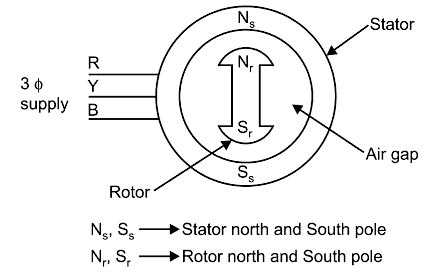
Step 2.
- Due to the Rotating Magnetic field, let the stator poles i.e North poles (Ns) and South Poles (Ss) rotate with synchronous speed.
- At a particular time stator pole, Ns coincides with the rotor poles Nr and SS coincides with Sr i.e like poles of the stator and rotor coincide with each other.
- As we know, like poles experience a repulsive force. So rotor poles experience a repulsive force Fr. Let us assume that the rotor tends to rotate in the anti-clockwise direction as shown in Fig. (i).
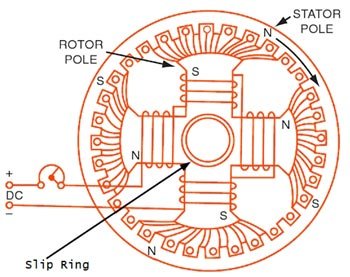
Step-3.
- After half cycle, the polarity of the stator pole is reversed, whereas the rotor poles cannot change their polarity as shown in Fig. (ii).
- Now unlike poles of rotor and Stator coincide with each other and rotor experiences the attractive force fa and the rotor tends to rotate in the clockwise direction.
- In brief, we can say, with the rotation of stator poles the rotor tends to drive in the clockwise and anti-clockwise direction in every half cycle.
- Hence, to and fro motion is excited on the rotor and as a result, the rotor does not rotate. As a result, the average torque on the rotor is zero. Hence the 3-phase synchronous motor is not a self-starting motor.
In order to develop a continuous torque, the two fields must be stationary with respect to each other. This is possible when the rotor also rotates at synchronous speed. The basic principle of synchronous motor operation is that the rotor chases the stator magnetic field. In other words, the stator rotating magnetic field tends to drag the rotor along as if the north pole on the stator locks into the south pole of the rotor.
Step 4.
- If the rotor of the synchronous motor is rotated by some external means at the start so that it also reverses its polarity as the polarity of the stator poles, there exists a continuous force of attraction between stator and rotor poles. This is called magnetic locking.
- Once the magnetic locking is obtained, the rotor poles are dragged by the stator revolving field (or imaginary poles) and a continuous torque is obtained. As the rotor poles are dragged by the stator revolving field, hence the rotor rotates at the same speed as that of the stator revolving field, i.e., at synchronous speed.
Step 5. Due to this, the rotor continuously experiences a unidirectional torque in the direction of the rotating magnetic field. Hence 3-phase synchronous motor must run at synchronous speed.
What will happen if by chance the rotor position is in such a way that the, unlike the rotor and stator poles, are facing each other?
But owing to the large inertia of the rotor, the rotor fails to rotate along with the stator poles. Hence again the difference of position of magnetic axes gets created and the rotor gets subjected to quickly reversing torque. This is because the speed with which the magnetic field is rotating is so high that it is unable to rotate the rotor from its initial position, due to the inertia of the rotor. So under any case, whatever may be the starting position of the rotor, the synchronous motor is not self-starting.
In order to develop a continuous torque, the two fields must be stationary with respect to each other. This is possible when the rotor also rotates at synchronous speed. The basic principle of synchronous motor operation is that the rotor chases the stator magnetic field. In other words, the stator rotating magnetic field tends to drag the rotor along as if the north pole on the stator locks into the south pole of the rotor.
PROCEDURE TO START SYNCHRONOUS MOTOR
Now suppose the rotor is rotated by some external means at a speed almost equal to synchronous speed. And then the rotor is excited to produce its poles. At a certain instant now, the stator and rotor, unlike poles, will face each other such that their magnetic axes are near each other. Then the force of attraction between the two, pulls both of them into the magnetic locking condition.
Once magnetic locking is established, the rotor and stator poles continue to occupy the same relative position. Due to this, the rotor continuously experiences a unidirectional torque in the direction of the rotating magnetic field. Thence rotor rotates at synchronous speed and said to be in synchronism with a rotating magnetic field. The external device used to rotate the rotor near synchronous speed can be removed once synchronism is established. The rotor then continues its rotation at ^Ns due to magnetic locking. This is the reason why the synchronous motor runs only at synchronous speed and does not rotate at any speed other than the synchronous. This operation is shown in the Figures. (a) and (b).
It is necessary to keep field winding i.e., rotor excited from dc supply to maintain the magnetic locking as long as the motor is operating.
Procedure: A general procedure to start a synchronous motor can be stated as:
- Give a three-phase ac supply to the three-phase winding. This will produce a rotating magnetic
- field rotating at synchronous speed NS RPM.
- Then drive the rotor by some external means like the diesel engine in the direction of rotating the magnetic field, at a speed very near or equal to synchronous speed.
- Switch on the dc supply given to the rotor which will produce rotor poles. Now there are two fields one is the rotating magnetic field produced by the stator while the other is produced by the rotor which is physically rotated almost at the same speed as that of the rotating magnetic field.
- At a particular instant, both the fields get magnetically locked. The stator field pulls the rotor field into synchronism. Then the external device used to rotate the rotor can be removed. But rotor will continue to rotate at the same speed as that of the rotating magnetic field i.e., NS due to magnetic locking.
Note:- To start the synchronous motor, it needs some device to rotate the rotor at a speed very near or equal to the synchronous speed. In the next article, we will discuss the method of starting the synchronous motor.

